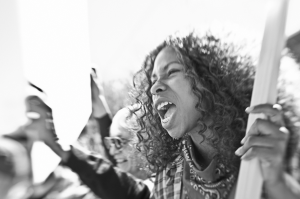
Close-up of a “Hello My Name Is” sticker on a lapel.
Imagine showing up to work and having your boss insist on calling you by a name that isn’t yours. You complain to HR but they back up the manager. They tell you if you complain again, you’ll be fired.
Now imagine not being able to do anything about this on the legal front.
This is the daily reality for trans people who work for employers who discriminate against them. Something as simple as having your name on your nametag is left at the mercy of your employer and, if you don’t like it, they’ll show you the door.
If the Trump administration gets their way, this will be a daily reality for trans people across the United States.
Late last month, Attorney General Jeff Sessions issued a memo arguing that trans people are not entitled to employment protections under Title VII of the 1963 Civil Rights Act, which bans employment discrimination on the basis of sex.
Arguing that protecting people on the basis of gender identity was never the intent of the original law, and Sessions has directed the Dept. of Justice to side with discriminatory employers in cases involving trans people.
Trans people depend on an ever-changing patchwork of legalese for scraps of protections and recourse against abusive employers and the DOJ’s recent move is just the latest salvo in this ongoing battle for basic rights at work.
The current situation can be a lot to keep up with and often leaves trans people in the dark when it comes to legal options.
Here are 8 things you need to know about the current state of trans employment:
1. Employment protections for trans people are badly needed
Trans people are three times more likely to be unemployed than the general population in the U.S., and it’s even worse for those with intersecting identities like people of color or folks with disabilities.
Employers can discriminate in several ways, from requiring dress and behavior aligning with birth sex, to denying access to appropriate restrooms, to refusing to even use a trans person’s name.
Currently, the trans community depends on a spotty patchwork of city and state level protections, as well as a recent but rich array of court rulings for protection against discrimination.
There has never been a law passed by the U.S. Congress that protects trans people at work in any way.
2. The same law and court ruling that protects cis women from discrimination also protect trans people
A 1989 case involving a cis woman serves as the original legal precedent for trans protections under Title VII.
In Price Waterhouse v Hopkins, Ann Hopkins was denied a promotion because she didn’t dress or behave in a feminine enough manner for her managers. This ruling banned sex stereotyping under the law so employers could no longer require employees look and act in a gendered manner.
By banning sex stereotypes, the law means that sex cannot be any basis at all for discrimination. Employers can’t force trans employees to act or dress or even call themselves by their assigned sex at birth if they don’t want to.
The case solidified the right for cisgender women to transgress gender stereotypes at work quickly, but it’s taken much longer to trickle down to trans people. There are still new cases of trans discrimination getting filed, even in states like California that have very strong trans protections already on the books.
3. Individual court rulings have offered more hope for trans protections than existing federal law
Recently, Attorney General Jeff Sessions issued a memorandum declaring that all laws protecting against sex-based discrimination do not include protection for trans people or on the basis of gender identity.
However, based on a set of pro-trans court rulings, it’s been legally established that sex-based discrimination laws, like Title VII, do offer some employment protections for trans people in that sex cannot be a factor in potentially discriminatory employer policies or firings.
The rub is that under this model, trans people are thrown at the mercy of the courts and, again, may not find justice should they encounter a conservative judge or panel.
So, if someone sued after they were fired for being trans or were forced to dress and act in accordance with their birth sex, or because they weren’t allowed to use a new name, they aren’t automatically guaranteed protections, despite the previous court ruling.
4. Trans people are desperately looking for legal protections and, sometimes, finding solutions means creative lawyering
In addition to seeking protections under the aforementioned Title VII, a recent court case has sought to protect trans people under the Americans with Disabilities Act. Originally the bill’s language specifically excluded “transsexuality,” meaning trans people were left out.
Recently, however, a case brought forth by a trans woman against her employer has thrown that exclusion into doubt. The case argued that, since gender dysphoria is a medical diagnosis, it should be accommodated like any other medical diagnosis despite the original exclusion.
In Blatt vs Cabela’s, a trans woman claimed that since her gender dysphoria is a medical diagnosis, that she deserves reasonable accommodations like being allowed female dress options, access to the women’s restroom, and her female name on her nametag from her employer for that diagnosis.
In an interview for VICE, GLAD attorney Jennifer Levi, who wrote an amicus brief for the case notes that the ADA is meant to be used “where you’re only protected if you are capable of working and able to do the job, but you’re limited from doing the job because of the stigma associated with the medical condition.”
In other words, Levi argues that discrimination against someone perceived to have gender dysphoria should be accommodated just as anybody else with a diagnosed medical condition.
For the first time in history, a U.S. court agreed, ruling that Ms. Blatt and any future trans people can argue the constitutionality of the ADA’s exception for “transvestism or transsexuality.” Blatt’s case was later settled without an official ruling on whether or not gender dysphoria is covered under the ADA
Court proceedings can be complicated but, basically, the first judge granted that Blatt could argue that gender dysphoria should be covered. However, the case was settled before a judge could decide whether the ADA generally covers gender dysphoria or not.
Bottom line, trans people should already have explicit equal protection under the law and shouldn’t have to pursue creative legal solutions like seeking inclusion under laws meant to protect disabled people.
5. A powerful religious conservative advocacy group is spearheading the push against trans people
The Family Research Council (FRC), under noted transphobe Tony Perkins, created a 5 step plan to “counter the transgender agenda” early last year. It’s important for readers to note this because numerous Trump administration officials have direct ties to the FRC.
It should come as no surprise, then, that each point from the FRC anti-trans plan has been adopted within the national GOP platform. The plan itself has 5 main points:
- States and the federal government should not allow legal gender marker changes.
- Transgender people should not have any legal protections against discrimination, nor should anyone be forced to respect their identity.
- Transgender people should not be legally allowed to use facilities in accordance with their gender identity.
- Medical coverage related to transition should not be provided by the government, or any other entity.
- Transgender people should not be allowed to serve in the military.
Imagine, if you will, not being able to obtain an accurate legal ID. Every interaction you have involving IDs — from buying alcohol to a routine traffic stop to applying for a job — would risk harassment or even arrest because no one would believe your ID represents who you are.
This plan has nothing to do with religion or religious freedom and instead seeks to make life as difficult as possible for trans people. A life without medical care, without a safe place to pee in peace, without even an accurate government ID, is an intolerable, arguably impossible one.
Already, we can see the early results of this agenda under the Trump administration, including the revocation of the Obama-era trans student guidance in February, the trans military ban, and the DOJ Title VII memo. These actions all follow FRC guidelines for discriminating trans people out of American society.
The FRC plan also calls for bathroom bills in every state and on the national level as well as revocation of all local trans legal protections.
6. Employment protections for trans people depends entirely on geography
Currently, the strongest protections for trans people come at the individual state level, with 20 states plus DC currently with trans employment protections on the books. With 31 state houses currently under GOP control, trans protections are often a non-starter.
With eight new trans officials winning elected office in this past election and more than 30 more on the ballot next year, a Democratic wave offers the best hope for finally advancing trans protections throughout the country.
I’m lucky to live in a state with full trans accommodations, including employment. For me, this means that legally, my employer couldn’t just fire me when I let them know I’d be transitioning. The end result of those protections is that I had more say in my own transition than I would have if I had been at the mercy of my employer’s whims.
In more conservative states, often the only option for trans people is to live and work in a more progressive city with its own citywide trans protections. In fact, in states like Texas and North Carolina, trans advocacy has proved necessary in order to stop further erosion of already limited municipal trans protections.
7. Democrats turned their back on trans protections
In 2007, the U.S. Congress debated the Employment Non-Discrimination Act (ENDA), that would have protected LGBTQ people from discrimination in matters of employment, housing, and public accommodations.
But Democrats pushing for the bill did not have the necessary GOP votes to pass it without splitting gender identity from the bill.
As such, Human Rights Campaign and Representative Barney Frank, a gay Democrat from Massachusetts, began pushing to separate trans people from the bill, causing a vicious rift within the queer community and within the Democratic party itself.
After decades of advocacy alongside our LGB siblings, the trans community felt rightly betrayed.
The debate and subsequent statements on the matter exposed Rep. Frank’s deeply held transmisogyny, particularly against trans women who haven’t had bottom surgery.
It’s disappointing, to say the least, that a member of the LGBTQ community who was unable to work past his own internalized transmisogyny was the one to kill hope for trans equality in Congress.
The bill was never able to recover from this division and was shelved despite being passed in the Senate in 2013 and President Obama’s support.
Still, there is hope that ENDA may pass in the future with a Democratically controlled Congress and White House. This will only be made easier now that the transmisogynist Rep. Frank retired from the House of Representatives.
Passing a trans-inclusive ENDA would finally make discrimination against trans people — and every other letter in the LGBTQ acronym — explicitly illegal nationwide. This would mean no more pushing for court rulings that piggyback off of protections that were originally meant not to apply to trans people like Title VII or the ADA.
We must not succumb to the transphobic conservative pressure that allows us to separate the ‘T’ from ‘LGBTQ’. Signing ENDA into law would finally send a full-throated message that trans people in the U.S. are full and equal citizens entitled to the same legal rights and privileges as everybody else.
8. After ENDA’s failure, the LGBTQ community began an all-out push for marriage equality
In the wake of the ENDA debacle, LGBTQ advocacy groups began an earnest push for much-needed marriage equality.
Marriage equality was a critically important achievement for the queer community, especially since LGBTQ folks previously had no power to make medical or financial decisions for lifelong partners in need, or the right to inherit a partner’s wealth or partake in a partner’s employment benefits.
With most trans people identifying as something other than straight, marriage equality is also a win for the community. However, the push for marriage took valuable resources and attention away from efforts to get equal protection laws on the books — something that has always been a priority for the trans community.
As a result, there is a scarcity of protections for trans people that live in all but the most progressive areas of the country, like California and New York. Consistent political work toward equal protections for all LGBTQ people would have meant that more trans people would have the legal protections we so desperately need.
Additionally, after taking a victory lap after achieving marriage equality, advocacy groups took their eye off the ball and weren’t ready for the FRC’s all-out assault on trans rights.
Starting with the referendum to repeal the city of Houston’s LGBTQ protections ordinance, there has been a systematic assault on the legal rights of trans people across the U.S. under the guise of keeping “men out of women’s bathrooms” — a slogan born out of that Texas election.
***
Federal trans employment rights currently stand on a political knife’s edge. And with a major party declaring war on the trans community, it’s hard to see a way for trans people to find relief from discrimination without a massive wave of new Democratic legislators at all levels.
The thought of navigating the current patchwork of half-measures can feel hopeless for a trans person who’s been fired just for being trans. Especially when there is a chance they’ll struggle to get hired for a new job because they’re trans.
The trans community needs official institutions tasked with protecting our rights as individuals, especially from those that wish to marginalize us from our jobs and careers.
[do_widget id=’text-101′]
Katelyn Burns is an Everyday Feminism Reporting Fellow. Katelyn is a freelance journalist and trans woman. She has previous bylines for The Washington Post, The Establishment, and VICE, among others. She lives in Maine with her two young children. Read her other articles here.
Search our 3000+ articles!
Read our articles about:
Our online racial justice training
Used by hundreds of universities, non-profits, and businesses.
Click to learn more




















